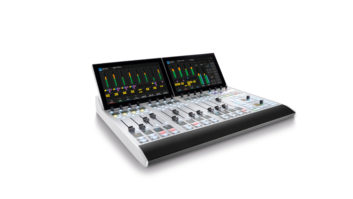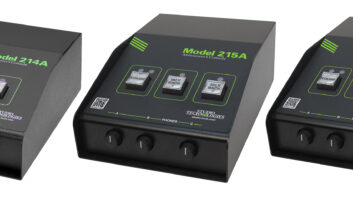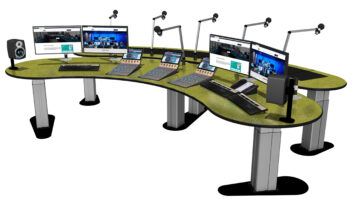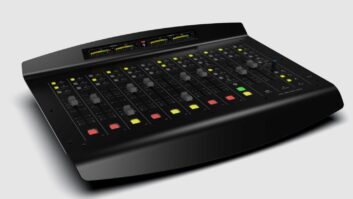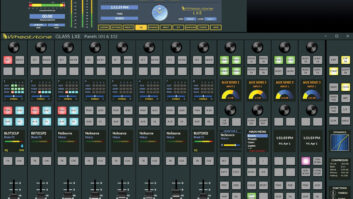All About Audio Consoles
Feb 1, 2003 12:00 PM, By Gordon S. Carter, CPBE
Through a greater degree of integration, theconsole surface can display more information to theoperator.

The audio console serves as the central control point for all audiopassing through the radio station. Depending on the station’s needs, itmay be a simple device with only a few controls or a mammoth consolewith enough controls to make any techno-geek happy. The controls rangefrom simple level (volume) controls to sophisticated responseequalization. It may contain controls for multiple auxiliary sends formix-minuses and IFB. It may even contain the control panel for arouting switcher and on-air telephone system.
The audio consoles of today can be divided into two groups: analogand digital. Analog consoles are popular and are still widelymanufactured. Analog consoles tend to be less expensive than digitalconsoles, but this is changing rapidly. If a need calls for a smallconsole, analog consoles are more cost-effective, and possibly the onlysolution available. There are few small digital consoles available, andmost of those are not intended for broadcast use. As your needs growinto larger and more complicated consoles, the likelihood of finding acost-effective digital console increases. The primary reason for thisis the development cost of new products. Generally, new technology isintroduced at the high end of the price range, and gradually tricklesdown to the lower-priced units as the initial development costs aredefrayed. At last year’s NAB, prices for high-end digital consoles werejust beginning to be cost-competitive with comparable analog consoles.It won’t be much longer until digital consoles will be considerablycheaper than comparable analog consoles.
The analog consoles that are available now possess incrementaladvances on previous technology. While most don’t look much differentthan older consoles, they often incorporate advanced features such assurface-mount components and modular construction. Many of theseadvances contribute to better initial performance and betterreliability. Many are even providing indicators that never needreplacing during the life of the console through the use of LED lampsor LCD displays. Electronic switching also helps improve reliability byreducing the problems associated with dirty switch contacts.
A seasoned change
The real changes have been in the area of digital consoles. For theuninitiated, digital consoles accept digital signals or convert analogsources to digital, then manipulate these signals by altering, mixing,processing and controlling them with no degradation (assuming thedigital system has been designed properly). With the proliferation ofdigital sources in the radio stations today (CDs, computers and digitalsatellites), the digital console has the advantage of not having toconvert all these signals back to analog and then to digital again. Thedigital source can remain digital throughout the entire system, all theway to the transmitter.
A wide choice in digital consoles existsto fit small and large installations.
Digital console manufacturers have opted to follow two design paths.Some have patterned their digital consoles after a typical analogconsole. These consoles are self-contained with the possible exceptionof the power supply. The audio (analog or digital) is brought to theconsole housing and controlled in dedicated console sections.
The other approach provides a unit that houses most of theelectronics. The audio comes to and from this central unit, oftencalled an audio engine, which does not have to be at the consoleoperator’s location. A control surface is connected to the enginethrough a digital connection, usually a serial or CAT-5 cable. Thecontrol surface issues digital commands to the central unit that tellit what to do with the audio.
All of this wizardry of the high-end digital consoles is madepossible by integrating the console with a digital routing switcher. Inmost cases, the console surface and the router are from the samemanufacturer, but there are some choices that combine onemanufacturer’s surface with another’s router. The router capabilitygreatly expands the capability of the console, allowing control ofaudio from multiple sources and destinations with a limited number ofconsole channels.
As the console is more fully integrated with the routing switcher itis possible to have multiple consoles (control surfaces) operating withone routing switcher, so audio sources can be easily shared amongcontrol rooms without the use of additional wiring and distributionamplifiers. The audio source is connected directly to the router. Ifthe source is digital, it goes straight in. If it is analog, it isconverted to digital (usually in the router) and is then available tothe system. One or more control rooms can use this source at the sametime with no additional work, since the router takes care of itall.
Some console designs use video displayfor system functions and metering. These displays can also be used forother equipment displays, minimizing the clutter in the studio.

The same can be true for outputs from the console. Most consoleshave several outputs, usually identified as program, audition,auxiliary, utility, sends and mix-minus. The way in which it is useddefines the primary difference between any of these outputs. They areall audio outputs, but the compliment of sources assigned to them givesthem greater flexibility. By using a routing switcher to multiply thecapability, digital consoles can appear to have more outputs than theyphysically have.
The addition of the routing switcher has now expanded the capabilityof the system, making the console a virtual chameleon, able to changecharacter at a moment’s notice. This feature alone has made digitalconsoles more attractive to radio owners with more than one station ina market. Once a system is set up, resources can be shared and thefacility’s entire operations can be consolidated.
Another new feature available on digital consoles is an expandeddisplay. Some digital consoles no longer use dedicated meters, but usea computer monitor instead � often a flat-screen display �to indicate audio mix levels, the time and count-up or count-downtimer. When the auxiliary controls are activated, these monitors willdisplay information corresponding to these controls. Some even show agraphical representation of the equalization or compression settings onthe screen. Because all the audio is being processed digitally, thissort of advanced display is a logical progression. When a display likethis is used, more monitors can be added for automation and newssystems to create a fully integrated appearance in the controlroom.
Cost and effect
By now you are probably thinking that all of this is going to add upto a lot of money, and you may be right. However, remember that you arebuying more than just a console with these high-end systems. You arebuying multiple consoles and a routing switcher. When you do a detailedcost comparison, you may find it is less expensive than youthought.
The purchase decision goes beyond price, features and performance.Most manufacturers will provide a user list on request. Manufacturersupport is also an important aspect. Make sure the company provides thekind of support the stations need. Look into parts and costs forreplacement items, especially lamps and indicators, switches and othermechanical items that will wear quickly.
Don’t let the variety of consoles intimidate you. Yes, there arelots of options, but you will quickly find that many are not a good fitfor your station. Eliminate them one-by-one and you will eventuallycome down to a few choices that will be right for you.
Gordon Carter is chief engineer of WFMT-FM, Chicago.
More online
Looking for console manufacturers to help you plan your nextproject? A complete list is available in the online version of thisarticle at www.beradio.com.





